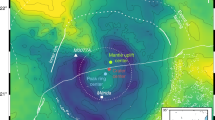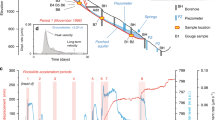Abstract
Large meteorite impact structures on the terrestrial bodies of the Solar System contain pronounced topographic rings, which emerged from uplifted target (crustal) rocks within minutes of impact. To flow rapidly over large distances, these target rocks must have weakened drastically, but they subsequently regained sufficient strength to build and sustain topographic rings. The mechanisms of rock deformation that accomplish such extreme change in mechanical behaviour during cratering are largely unknown and have been debated for decades. Recent drilling of the approximately 200-km-diameter Chicxulub impact structure in Mexico has produced a record of brittle and viscous deformation within its peak-ring rocks. Here we show how catastrophic rock weakening upon impact is followed by an increase in rock strength that culminated in the formation of the peak ring during cratering. The observations point to quasi-continuous rock flow and hence acoustic fluidization as the dominant physical process controlling initial cratering, followed by increasingly localized faulting.
This is a preview of subscription content, access via your institution
Access options
Access Nature and 54 other Nature Portfolio journals
Get Nature+, our best-value online-access subscription
$29.99 / 30 days
cancel any time
Subscribe to this journal
Receive 51 print issues and online access
$199.00 per year
only $3.90 per issue
Buy this article
- Purchase on Springer Link
- Instant access to full article PDF
Prices may be subject to local taxes which are calculated during checkout





Similar content being viewed by others
Data availability
All data generated or analysed during this study are included in this published Article. Other Expedition 364 data are available online (https://doi.org/10.14379/iodp.proc.364.2017).
Change history
13 November 2018
In this Article, the middle initial of author Kosei E. Yamaguchi (of the IODP–ICDP Expedition 364 Science Party) was missing and his affiliation is to Toho University (not Tohu University). These errors have been corrected online.
References
Croft, S. K. The modification stage of basin formation: conditions of ring formation. Geochim. Cosmochim. Acta 12A, 227–257 (1981).
Grieve, R. A. F., Robertson, P. B. & Dence, M. R. Constraints on the formation of ring impact structures, based on terrestrial data. Geochim. Cosmochim. Acta 12A, 37–57 (1981).
Neumann, G. A. et al. Lunar impact basins revealed by gravity recovery and interior laboratory measurements. Sci. Adv. 1, e1500852 (2015).
Ivanov, B. A. Numerical modelling of the largest terrestrial meteorite craters. Sol. Syst. Res. 39, 381–409 (2005).
Melosh, H. J. & Ivanov, B. A. Impact crater collapse. Annu. Rev. Earth Planet. Sci. 27, 385–415 (1999).
O’Keefe, J. D. & Ahrens, T. J. Planetary cratering mechanics. J. Geophys. Res. 98, 17011–17028 (1993).
Wünnemann, K. & Ivanov, B. A. Numerical modelling of the impact crater depth-diameter dependence in an acoustically fluidized target. Planet. Space Sci. 51, 831–845 (2003).
Grady, D. E. & Kipp, M. E. in Fracture Mechanics of Rock (ed. Atkinson, B. K.) 429–475 (Academic Press, London, 1987).
Fujiwara, A., Kamimoto, G. & Tsukamoto, A. Destruction of basaltic bodies by high-velocity impact. Icarus 31, 277–288 (1977).
Ahrens, T. J. & Rubin, A. M. Impact-induced tensional failure in rock. J. Geophys. Res. 98, 1185–1203 (1993).
Buhl, E. et al. Particle size distribution and strain rate attenuation in hypervelocity impact and shock recovery experiments. J. Struct. Geol. 56, 20–33 (2013).
Collins, G. S. Numerical simulations of impact crater formation with dilatancy. J. Geophys. Res. 119, 2600–2619 (2014).
Melosh, H. J., Ryan, E. V. & Asphaug, E. Dynamic fragmentation in impacts: hydrocode simulation of laboratory impacts. J. Geophys. Res. 97, 14,735–14,759 (1992).
Kenkmann, T. Folding within seconds. Geology 30, 231–234 (2002).
Kenkmann, T. Dike formation, cataclastic flow, and rock fluidization during impact cratering: an example from the Upheaval Dome structure, Utah. Earth Planet. Sci. Lett. 214, 43–58 (2003).
Collins, G. S., Melosh, H. J. & Ivanov, B. A. Modeling damage and deformation in impact simulations. Meteorit. Planet. Sci. 39, 217–231 (2004).
Senft, L. E. & Stewart, S. T. Dynamic fault weakening and the formation of large impact craters. Earth Planet. Sci. Lett. 287, 471–482 (2009).
Spray, J. G. Superfaults. Geology 25, 579–582 (1997).
Melosh, H. J. Acoustic fluidization: a new geological process? J. Geophys. Res. 84, 7513–7520 (1979).
Melosh, H. J. Dynamical weakening of faults by acoustic fluidization. Nature 379, 601–606 (1996).
Grieve, R. A. F. & Therriault, A. Vredefort, Sudbury, Chicxulub: three of a kind? Annu. Rev. Earth Planet. Sci. 28, 305–338 (2000).
Grieve, R. A. F., Reimold, W. U., Morgan, J., Riller, U. & Pilkington, M. Observations and interpretations at Vredefort, Sudbury and Chicxulub: towards a composite kinematic model of terrestrial impact basin formation. Meteorit. Planet. Sci. 43, 855–882 (2008).
Collins, G. S., Melosh, H. J., Morgan, J. V. & Warner, M. R. Hydrocode simulations of Chicxulub crater collapse and peak-ring formation. Icarus 157, 24–33 (2002).
Morgan, J. V. et al. The formation of peak rings in large impact craters. Science 354, 878–882 (2016).
Morgan, J. V., Warner, M. R., Collins, G. S., Melosh, H. J. & Christeson, G. L. Peak-ring formation in large impact craters: geophysical constraints from Chicxulub. Earth Planet. Sci. Lett. 183, 347–354 (2000).
Morgan, J. V. et al. Full waveform tomographic images of the peak ring at the Chicxulub impact crater. J. Geophys. Res. 116, B06303 (2011).
Gulick, S. P. S. et al. Importance of pre-impact crustal structure for the asymmetry of the Chicxulub impact crater. Nat. Geosci. 1, 131–135 (2008).
Morgan, J. V. et al. Chicxulub: drilling the K-Pg impact crater. In Proceedings of the International Ocean Discovery Program 364 https://doi.org/10.14379/iodp.proc.364.2017 (International Ocean Discovery Program, College Station, 2017).
Christeson, G. L. et al. Extraordinary rocks from the peak ring of the Chicxulub impact crater: P-wave velocity, density, and porosity measurements from IODP/ICDP Expedition 364. Earth Planet. Sci. Lett. 495, 1–11 (2018).
Petit, J. P. Criteria for the sense of movement on fault surfaces in brittle rocks. J. Struct. Geol. 9, 597–608 (1987).
Berthé, D., Choukroune, P. & Jegouzo, P. Orthogneiss, mylonite and non-coaxial deformation of granites: the example of the South Armorican Shear Zone. J. Struct. Geol. 1, 31–42 (1979).
Ivanov, B. A. & Artemieva, N. A. in Catastrophic Events and Mass Extinctions: Impact and Beyond (eds C. Koeberl, C. & MacLeod, K. G.) Geological Society of America Special Paper 356, 619–630 (GSA, 2002).
Johnson, B. C., Campbell, C. S. & Melosh, H. J. The reduction of friction in long runout landslides as an emergent phenomenon. J. Geophys. Res. 121, 881–889 (2016).
Kring, D. A., Kramer, G. Y., Collins, G. S., Potter, R. W. K. & Chandnani, M. Peak-ring structure and kinematics from a multi-disciplinary study of the Schrödinger impact basin. Nat. Commun. 7, 13161 (2016).
Ivanov, B. A., Kocharyan, G. G. & Kostuchenko, V. N. Puchezh-Katunki impact crater: preliminary data on recovered core block structure. In Proc. 27th Lunar and Planetary Science Conf. 589–590, https://www.lpi.usra.edu/meetings/lpsc1996/pdf/1295.pdf (1996).
Kenkmann, T., Collins, G. S. & Wünnemann, K. in Impact Cratering: Processes and Products (eds Osinski, G. R. & Pierazzo, E.) 60–75 (John Wiley & Sons, Chichester, 2013).
Rae, A. S. P., Collins, G. S., Grieve, R. A. F., Osinski, G. R. & Morgan, J. V. Complex crater formation: insights from combining observations of shock pressure distribution with numerical models at the West Clearwater Lake impact structure. Meteorit. Planet. Sci. 52, 1330–1350 (2017).
Gulick, S. et al. in Proceedings of the International Ocean Discovery Program Volume 364 (eds Morgan, J. et al.) 1–46 (IODP, 2017).
Ortner, H., Reiter, F. & Acs, P. Easy handling of tectonic data: the programs Tectonics FP for Mac and Tectonics FP for Windows. Comput. Geosci. 28, 1193–1200 (2002).
Collins, G. S. et al. Dynamic modeling suggests terrace zone asymmetry in the Chicxulub crater is caused by target heterogeneity. Earth Planet. Sci. Lett. 270, 221–230 (2008).
Acknowledgements
This work was supported by the Priority Programs 527 and 1006 of the German Science Foundation (grants Ri 916/16-1 and PO 1815/2-1), National Science Foundation grants (OCE-1737351, OCE-1450528 and OCE-1736826), and Natural Environment Research Council (grants NE/P011195/1 and NE/P005217/1). The Chicxulub drilling expedition was funded by the European Consortium for Ocean Research Drilling (ECORD) and the IODP as Expedition 364 with co-funding from the ICDP. The Yucatan State Government and Universidad Nacional Autónoma de México (UNAM) provided logistical support. This research used samples and data provided by IODP. Samples can be requested at http://web.iodp.tamu.edu/sdrm. We are grateful for assistance from the staff of the IODP Core Repository in Bremen, Germany, during the Onshore Science Party. We thank B. Ivanov and C. Koeberl for constructive reviews and S. Teuber for assistance in figure preparation. This is UTIG contribution number 3,278.
Reviewer information
Nature thanks B. Ivanov and C. Koeberl for their contribution to the peer review of this work.
Author information
Authors and Affiliations
Consortia
Contributions
U.R., M.H.P., A.S.P.R., J.V.M., S.P.S.G. and R.A.F.G. conceived the study. All authors participated in sampling and data collection offshore and/or onshore during IODP-ICDP Expedition 364, interpretation of the data as well as writing and/or editing of the manuscript. U.R. provided the first draft of the manuscript. U.R. and F.M.S. acquired structural data from line scans. J.L. and A.D. provided the downhole orientation data. A.S.P.R and G.S.C. performed and analysed the numerical models; G.S.C., A.S.P.R. and H.J.M. contributed the discussion on the implications for acoustic fluidization.
Corresponding author
Ethics declarations
Competing interests
The authors declare no competing interests.
Additional information
Publisher’s note: Springer Nature remains neutral with regard to jurisdictional claims in published maps and institutional affiliations.
Extended data figures and tables
Extended Data Fig. 1 Lower-hemisphere, equal-area diagrams showing poles to pre-impact aplite, diabase and pegmatite sheet intrusions.
N, north. n, number of dykes.
Extended Data Fig. 2 Diagram showing pressure versus time as recorded by 100 Lagrangian tracer particles in the peak-ring rocks.
(See Supplementary Video for location of tracer particles). Grey circles show the pressure of each tracer particle at time intervals of 2 s. The black solid line shows average pressure (all tracer particles). We note the elevated pressures between T = 100 s and T = 250 s during central uplift formation and collapse.
Supplementary information
Video 1
Animation of the numerical simulation results. The target (and impactor) materials are indicated by colour, consistent with the individual frames shown in Fig. 2 (carbonate rock, grey; crust, pink; mantle, green). Large-scale deformation of the entire target is illustrated by a grid of Lagrangian tracer particles (black dots) with 2-km initial spacing. In addition, 100 tracer particles within the peak-ring rocks are highlighted in blue. The inset shows the same tracer particles in a Lagrangian reference frame centered on the average coordinates of the highlighted tracer particles.
Rights and permissions
About this article
Cite this article
Riller, U., Poelchau, M.H., Rae, A.S.P. et al. Rock fluidization during peak-ring formation of large impact structures. Nature 562, 511–518 (2018). https://doi.org/10.1038/s41586-018-0607-z
Received:
Accepted:
Published:
Issue Date:
DOI: https://doi.org/10.1038/s41586-018-0607-z
Keywords
This article is cited by
-
The Chicxulub impact and its environmental consequences
Nature Reviews Earth & Environment (2022)
-
Chicxulub Crater Joint Gravity and Magnetic Anomaly Analysis: Structure, Asymmetries, Impact Trajectory and Target Structures
Pure and Applied Geophysics (2022)
-
Change of crack mode in rock cracking process under quasi-static and dynamic loadings
Geomechanics and Geophysics for Geo-Energy and Geo-Resources (2022)
-
Natural and experimental high-pressure, shock-produced terrestrial and extraterrestrial materials
Progress in Earth and Planetary Science (2021)
-
Imaging the Chicxulub Central Crater Zone from Large-Scale Seismic Acoustic Wave Propagation and Gravity Modeling
Pure and Applied Geophysics (2021)
Comments
By submitting a comment you agree to abide by our Terms and Community Guidelines. If you find something abusive or that does not comply with our terms or guidelines please flag it as inappropriate.



